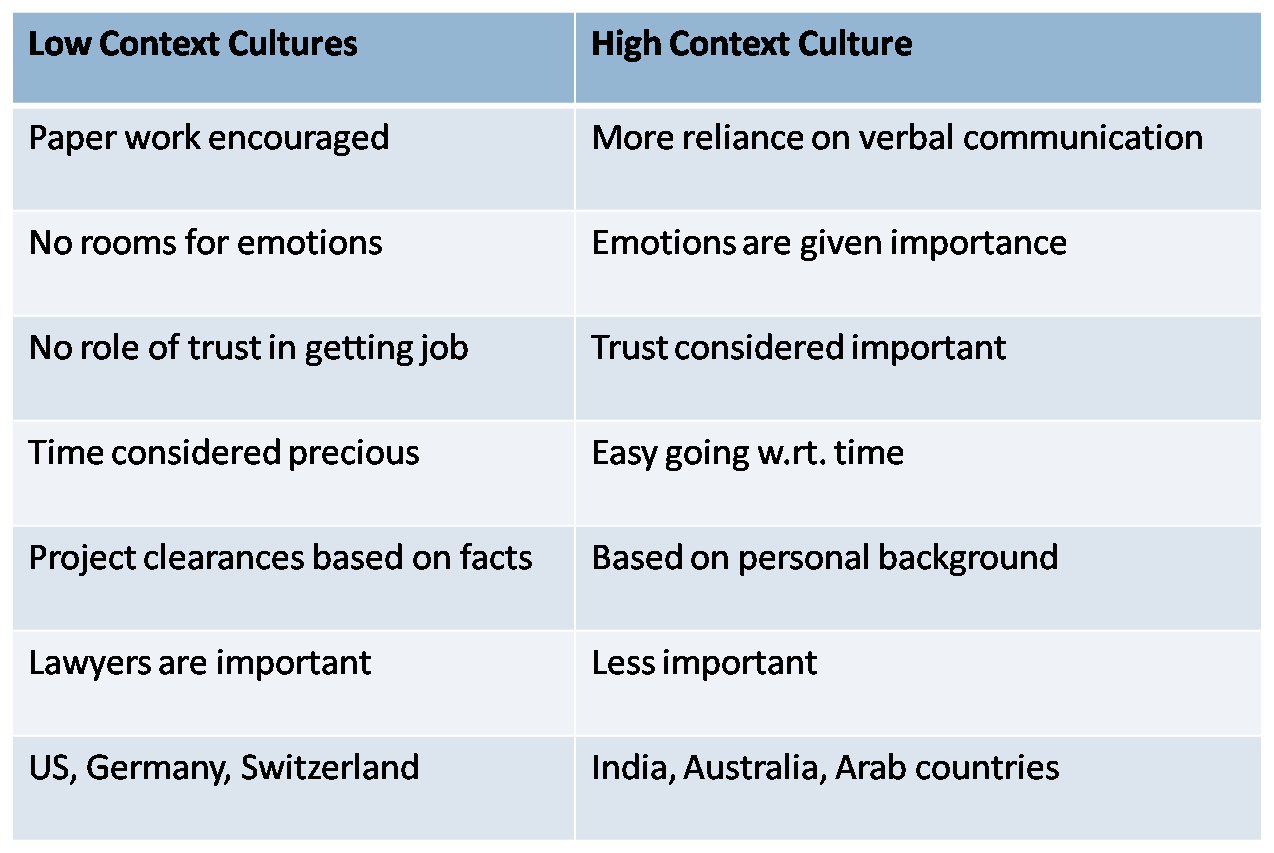Imagine stepping into a business meeting in Japan, where subtle cues and unspoken meanings are paramount. Now, picture yourself in a straightforward, direct meeting in the United States, where clear communication is valued. This stark contrast illustrates the fundamental differences between high and low context cultures.

Image: robsegers.blogspot.nl
The way we communicate, interpret information, and build relationships is deeply influenced by our cultural background. This article delves into the fascinating world of high vs low context cultures, exploring their nuances, implications, and how understanding these differences can facilitate smoother intercultural interactions.
Navigating the Cultural Landscape
Decoding High Context Culture
In high context cultures, meaning is heavily reliant on shared understandings, nonverbal cues, and implicit knowledge. Imagine a close-knit family where a simple glance or a subtle gesture can convey volumes. Similarly, in high context cultures, communication is often nuanced, relying on shared history, social status, and unspoken rules.
Consider Japan as a prime example of a high context culture. Building trust and rapport is crucial, and communication often involves indirect language, formal etiquette, and respectful deference to authority. Subtle gestures, facial expressions, and even the pitch of one’s voice carry significant meaning. In such cultures, explicitly stating things directly can be considered rude or disrespectful.
Low Context Culture: Direct and Explicit Communication
In contrast, low context cultures emphasize clear, direct communication where meaning is explicitly stated. Think of a classroom where instructions are given clearly and the teacher uses explicit language to explain concepts. Similarly, in low context cultures, communication is direct, relying on verbal language and less on implicit cues.
Western countries like the United States and Germany are often considered low context cultures. Communication is typically straightforward, with a focus on clear and explicit messages. Logic, rationality, and individualistic values are valued, and individuals are expected to speak their minds clearly and assertively.

Image: helengunadi.blogspot.com
The Spectrum of Context
It’s important to note that these two extremes represent a spectrum. Many cultures fall somewhere in between high and low context. For example, cultures like China and India, while considered high-context, may demonstrate some aspects of low context communication in certain situations. Additionally, an individual’s social status, profession, and personal experiences can influence their communication style even within a particular culture.
Implications for Intercultural Communication
Understanding the differences between high and low context cultures is essential for effective and smooth intercultural communication. For those working in diverse teams, conducting business across borders, or simply engaging in cross-cultural interactions, developing cultural sensitivity is critical.
When communicating with individuals from high context cultures, patience, active listening, and observing nonverbal cues are crucial. Be mindful that silence can be a powerful tool for conveying meaning in high context cultures. It’s also important to be respectful of established hierarchies and social norms.
In low context cultures, clear and direct communication is paramount. Individuals should strive for clarity in their messages, providing explicit details and avoiding ambiguity. It is necessary to be aware of cultural differences in humor and sarcasm, as these forms of communication can be misinterpreted in cross-cultural settings.
Latest Trends and Developments
In the ever-evolving landscape of globalization, the awareness of cultural differences is increasingly critical. With companies operating across continents and individuals connecting virtually, understanding communication styles across cultural divides becomes paramount. Tech giants like Google and Facebook are actively addressing cultural nuances in their products and services, striving to create inclusive platforms that cater to diverse audiences. This highlights the importance of understanding high vs low context cultures in the modern, interconnected world.
Expert Advice and Practical Tips
Here are some practical tips for navigating the complexities of high and low context communication:
- Be mindful of cultural cues: Pay close attention to nonverbal signals, including body language, facial expressions, and tone of voice. These can provide valuable insights into the underlying meaning of communication.
- Embrace active listening: Listen attentively to understand both the spoken and unspoken messages being conveyed.
- Practice empathy and patience: Be patient and empathetic when communicating with individuals from different cultures. Recognize that communication styles may differ, and adjust your approach accordingly.
- Ask clarifying questions: If you are unsure about the meaning of a message, don’t hesitate to ask for clarity.
- Respect cultural norms: Show respect for cultural customs and traditions, particularly regarding greetings, social etiquette, and business practices.
By actively practicing these tips, you can improve your intercultural communication skills, build stronger relationships, and navigate cultural complexities with greater ease.
Frequently Asked Questions
Q: How can I determine whether a culture is high or low context?
A: There is no definitive list, as cultures are complex and multifaceted. However, consider factors like individualism vs. collectivism, communication styles, the role of nonverbal cues, and the importance of shared history and context.
Q: Is it possible to be both high and low context?
A: Yes, individuals can be influenced by both high and low context cultures, depending on their background, experience, and the specific situation.
Q: What are some common misunderstandings that arise from cultural differences in communication?
A: Common misunderstandings include: misinterpreting nonverbal cues, assuming that directness is always appreciated, misreading humor or sarcasm, and failing to consider cultural differences regarding topics like time, deadlines, and decision-making processes.
High Vs Low Context Culture
Conclusion
Understanding the differences between high and low context cultures is vital for effective communication in our increasingly globalized world. By embracing empathy, active listening, and cultural sensitivity, we can bridge cultural differences and foster stronger connections. Do you find yourself navigating these communication styles in your daily interactions? Share your experiences in the comments below!





